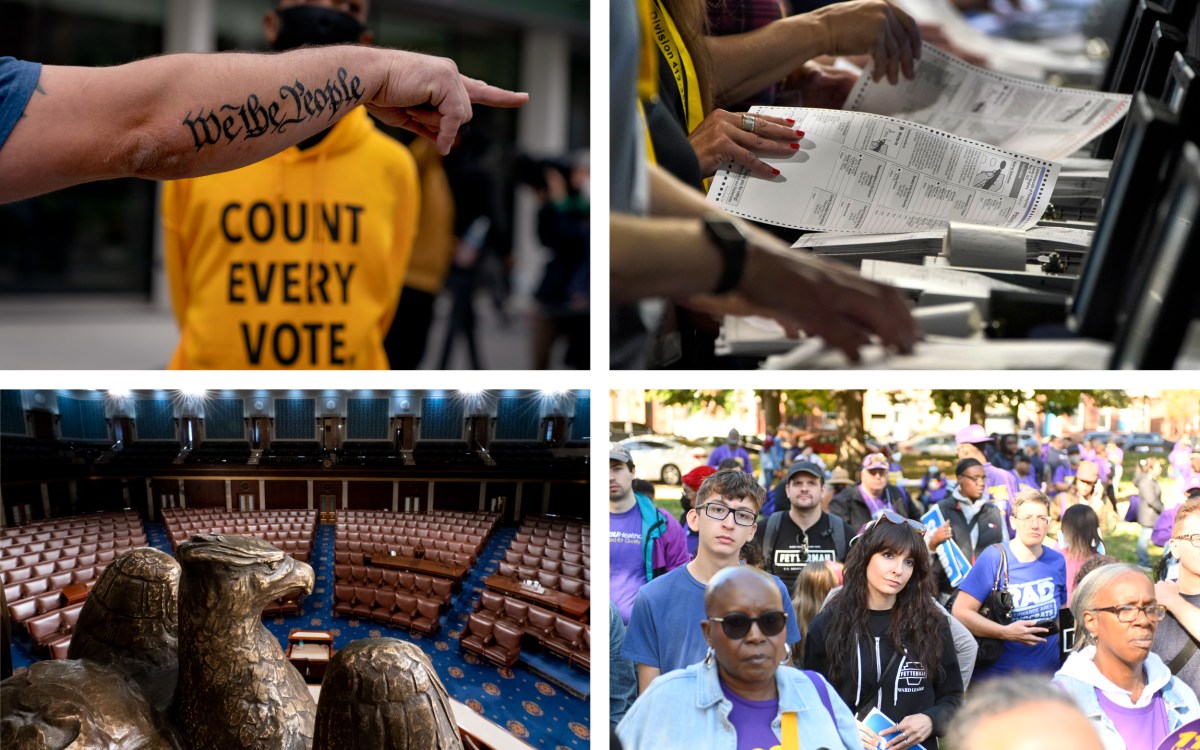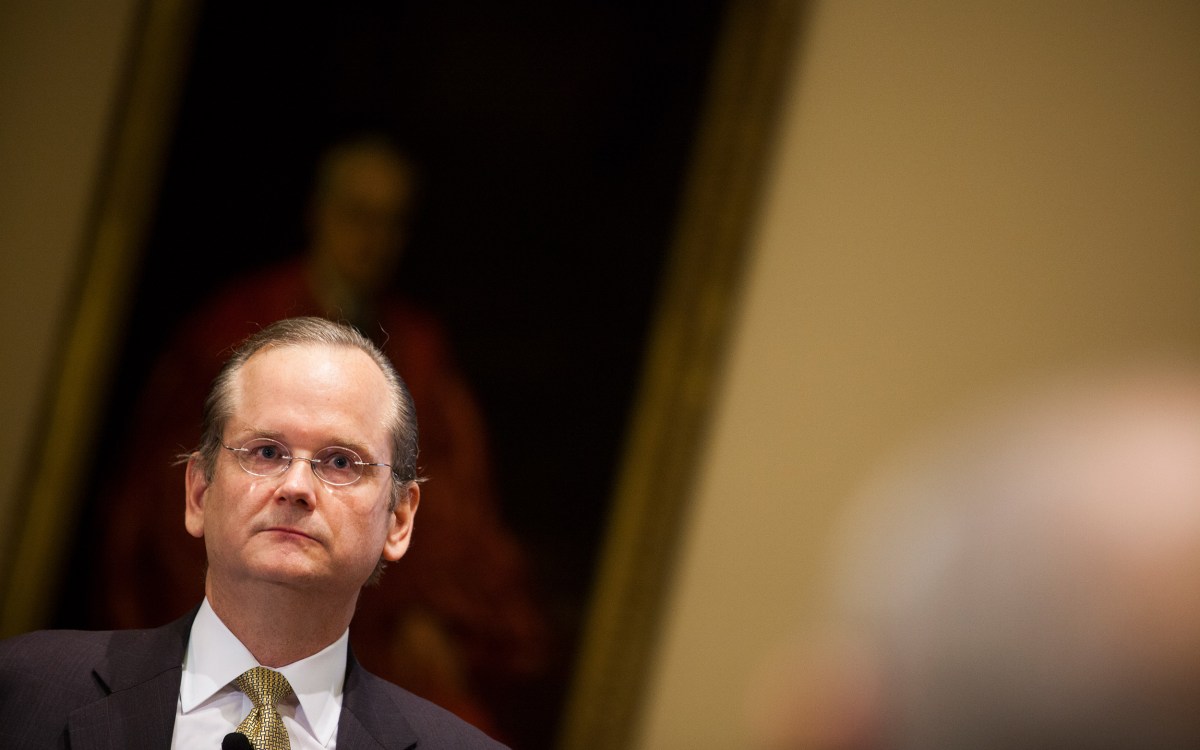‘Tyranny of the Minority’ warns Constitution is dangerously outdated

Steven Levitsky (left) and Daniel Ziblatt.
© Adam DeTour
Steven Levitsky and Daniel Ziblatt urge institutional reforms, rejection of candidates who violate norms in ‘How Democracies Die’ follow-up
The U.S. Constitution desperately needs updating, say Harvard government professors Steven Levitsky and Daniel Ziblatt.
“We have a very, very old constitution; in fact, the oldest written constitution in the world,” notes Ziblatt, the Eaton Professor of the Science of Government. “It was written in a pre-democratic era. It hasn’t been amended much compared to other democracies. As a result, we have these institutions in place that most other democracies got rid of over the course of the 20th century.”
In their new book “Tyranny of the Minority,” the comparative political scientists argue that these antiquated institutions, including the Electoral College, have protected and enabled an increasingly extremist GOP, which keeps moving farther to the right despite losing the popular vote in all but one of the last eight presidential elections. The scholars also survey governments worldwide for examples of democratizing reforms. And they draw from history in underscoring the dangers of our constitutional stasis.
Levitsky and Ziblatt’s 2018 bestseller, “How Democracies Die,” drew from global case studies to argue that Donald Trump represented a threat to core democratic principles, even flagging the possibility that he would refuse to cede power. Today, in light of the 2020 election — and the 147 Congressional Republicans who voted to overturn the results — the authors say it’s clear the threat is larger than Trump.
“The new book makes the case that large segments of the Republican Party leadership have lost commitment to democratic rules of the game,” said Levitsky, the David Rockefeller Professor of Latin American Studies and Professor of Government and director of the David Rockefeller Center for Latin American Studies at Harvard. “The fact that the party remains radicalized means the challenge is ongoing.”
The Gazette spoke with Levitsky and Ziblatt, who this week was named the next director of the Minda de Gunzburg Center for European Studies, about the state of the nation. The interview was edited for length and clarity.
Q&A
Steven Levitsky and Daniel Ziblatt
GAZETTE: You write that many U.S. institutions have fallen out of step with our peer democracies. What are some examples of this?
LEVITSKY: The United States has a plethora of counter-majoritarian institutions, some of which are essential to democracy. Our independent judiciary and our Bill of Rights are two examples. But we also have a set of counter-majoritarian institutions that don’t exist in most democracies and are arguably antithetical to democracy. The most obvious one is the Electoral College, which allows those who win fewer votes to capture the presidency.
Another is the U.S. Senate, which gives vast overrepresentation to sparsely populated states like Vermont and Wyoming and the Dakotas. It has repeatedly allowed the party that wins fewer votes to win control of the Senate. In addition, the filibuster is a super-majority rule; you need, in effect, 60 votes to pass legislation in the Senate.
ZIBLATT: I would add to that list also this: a federal judiciary with lifetime appointments. This structure allows political minorities from the past to dominate present-day majorities. I want to emphasize that Steve and I are not advocates of untrammeled majorities. But the combination of all these institutions leaves the U.S. in a situation where majorities have a harder time governing than any of our peer democracies — including many that according to all metrics are more vibrant democracies than our own.
“The United States did not become what contemporary political scientists would call a democracy until 1965.”
Steven Levitsky
GAZETTE: You note that our Constitution, drafted in a pre-democratic era, inspired many nascent democracies. But other governments have done more to update their constitutions. What are some of the key reforms seen elsewhere?
ZIBLATT: Most countries began the 20th century with upper chambers, or the equivalent to the Senate — the House of Lords in Britain, Germany’s Bundesrat. In places where they continue to exist, they were made much more proportional to population after 1945.
LEVITSKY: When Latin America became independent in the 1820s, Latin American elites designed their constitutions with the United States as a model. Therefore, the indirect election of the presidency was commonplace across the 19th and into the 20th century. All of these countries, over the course of the 20th century, eliminated their electoral colleges.
GAZETTE: The Electoral College comes off as a real relic in the book. How has it survived?
LEVITSKY: There have been serious efforts to abolish the Electoral College. In the late 1960s, a proposed constitutional amendment to replace it with direct presidential elections was supported by President [Richard] Nixon and leaders of both major parties, and it had majority support in both houses of Congress. It passed the House but failed to get the two-thirds majority needed in the Senate.
GAZETTE: One chapter revisits the United States during the late 19th century amid the backlash to Reconstruction and makes comparisons to the challenges of today. What are some of those parallels?
ZIBLATT: The first is that the pushback was often by political leaders who were interested in protecting their own interests. Southern Democrats were worried about being overwhelmed, in their view, by Black voters, who were majorities in many Southern states and by and large voted for the Republican Party. The second is the passage of various voting restrictions, essentially disempowering huge segments of the population. We call this constitutional hardball, where politicians pass laws to undermine democracy.
LEVITSKY: We don’t tend to focus much on this as Americans, but there were coups during the Reconstruction period — violent seizures of power, stolen elections. And authoritarian rule was consolidated via constitutional hardball, as Southern legislatures violated the 15th Amendment by using poll taxes, literacy tests, and other measures to strip African Americans’ right to vote for more than 70 years. The United States did not become what contemporary political scientists would call a democracy until 1965.
“Even if we get through the 2024 election with our democracy intact, unless we reform our democracy, we will remain in this fragile position where every national election is a national emergency.”
Daniel Ziblatt
GAZETTE: You also write about “semi-loyal democrats.” Who are they, and why do you consider them such a threat to democratic principles and policies?
LEVITSKY: We are drawing here from the eminent late Spanish political scientist Juan Linz, who wrote a very influential book in the 1970s about democratic breakdown. He distinguished between loyal, disloyal, and semi-loyal democrats. And semi-loyalists are tricky, because they look like normal politicians. They’re dressed in suits, not in “QAnon Shaman” costumes.
The real test between a loyal and a semi-loyal democrat is: What do they do when a threat to democracy emerges in their own camp? A loyal democrat is willing to cross the aisle and work with political rivals to isolate and defeat authoritarians. Semi-loyalists do not. When an authoritarian threat emerges, they will tolerate and even condone it. They will downplay violence and abuses of power or refuse to speak out against them. And they will refuse to work across the aisle in defense of democracy. That, unfortunately, is exactly what we saw after the 2020 election.
GAZETTE: You write that the U.S. is either becoming a truly multiracial democracy or we will not be a democracy at all. Where do things stand at this moment?
ZIBLATT: America has two different strands in its political life. On the one hand, overwhelming majorities support liberal democracy. Younger Americans also tend to be much more open to the demographic changes taking place. On the other hand, there is always a reaction to efforts to make our society more democratic. What we’re seeing in the lead-up to the 2024 election is a continued battle between these forces.
One of the points of our book is that the latter force tends not to be a majority, but we continue to be vulnerable given our institutions. We got through the 2020 election, just barely. Even if we get through the 2024 election with our democracy intact, unless we reform our democracy, we will remain in this fragile position where every national election is a national emergency.
GAZETTE: What can the individual citizen do to push for some of the reforms you see elsewhere?
ZIBLATT: In the short term, voting is critical. And specifically not voting for people who break democratic norms. In the long run, we have to change the structure of our politics. We propose a set of institutional changes in the book, but institutional reform doesn’t just happen on its own. It requires mass mobilization — generations of people pushing for institutional changes. One of the most inspiring examples for us was tracing the rise of the women’s suffrage movement through the 19th century. It took generations of women to change voting rules in the United States.
LEVITSKY: Don’t get tired. Don’t lose patience. Reconsolidating our democracy is going to take years and maybe decades. There will be wins. There will be losses. The women’s suffrage movement and the Civil Rights Movement show just how hard and long and slow a process this can be.







